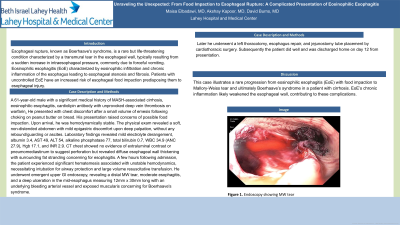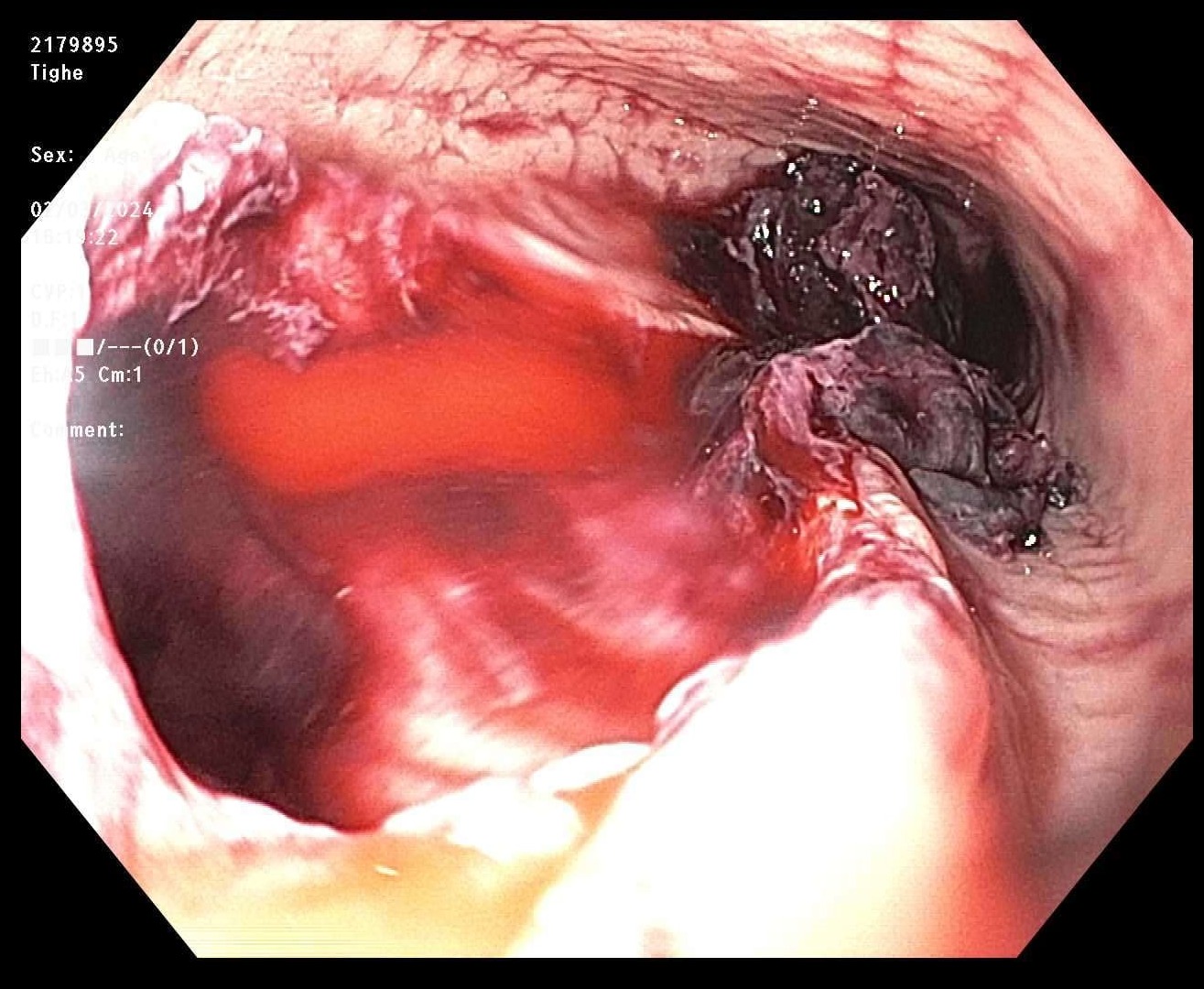Monday Poster Session
Category: Esophagus
P2278 - Unraveling the Unexpected: From Food Impaction to Esophageal Rupture: A Complicated Presentation of Eosinophilic Esophagitis
Monday, October 28, 2024
10:30 AM - 4:00 PM ET
Location: Exhibit Hall E

Has Audio

Maisa E. Elbadawi, MD
Lahey Hospital and Medical Center
Dracut, MA
Presenting Author(s)
Maisa E. Elbadawi, MD1, Akshay Kapoor, MD2, David Burns, MD2
1Lahey Hospital and Medical Center, Dracut, MA; 2Lahey Hospital and Medical Center, Burlington, MA
Introduction: Esophageal rupture, known as Boerhaave's syndrome, is a rare but life-threatening condition characterized by a transmural tear in the esophageal wall, typically resulting from a sudden increase in intraesophageal pressure, commonly due to forceful vomiting. Eosinophilic esophagitis (EoE) characterized by eosinophilic infiltration and chronic inflammation of the esophagus leading to esophageal stenosis and fibrosis. Patients with uncontrolled EoE have an increased risk of esophageal food impaction predisposing them to esophageal injury.
Case Description/Methods: A 61-year-old male with a significant medical history of MASH-associated cirrhosis, eosinophilic esophagitis, cardiolipin antibody with unprovoked deep vein thrombosis on warfarin. He presented with chest discomfort after a small volume of emesis following choking on peanut butter on bread. His presentation raised concerns of possible food impaction. Upon arrival, he was hemodynamically stable. The physical exam revealed a soft, non-distended abdomen with mild epigastric discomfort upon deep palpation, without any rebound/guarding or ascites. Laboratory findings revealed mild electrolyte derangement, albumin 3.4, AST 49, ALT 54, alkaline phosphatase 77, total bilirubin 0.7, WBC 34.9 (ANC 27.9), Hgb 17.1, and INR 2.9. CT chest showed no evidence of extraluminal contrast or pneumomediastinum to suggest perforation but revealed diffuse esophageal wall thickening with surrounding fat stranding concerning for esophagitis. A few hours following admission, the patient experienced significant hematemesis associated with unstable hemodynamics, necessitating intubation for airway protection and large volume resuscitative transfusion. He underwent emergent upper GI endoscopy, revealing a distal MW tear, moderate esophagitis, and a deep ulceration in the mid-esophagus measuring 12mm x 30mm long with an underlying bleeding arterial vessel and exposed muscularis concerning for Boerhaave's syndrome. Later he underwent a left thoracotomy, esophagus repair, and jejunostomy tube placement by cardiothoracic surgery. Subsequently the patient did well and was discharged home on day 12 from presentation.
Discussion: This case illustrates a rare progression from eosinophilic esophagitis (EoE) with food impaction to Mallory-Weiss tear and ultimately Boerhaave’s syndrome in a patient with cirrhosis. EoE’s chronic inflammation likely weakened the esophageal wall, contributing to these complications.

Disclosures:
Maisa E. Elbadawi, MD1, Akshay Kapoor, MD2, David Burns, MD2. P2278 - Unraveling the Unexpected: From Food Impaction to Esophageal Rupture: A Complicated Presentation of Eosinophilic Esophagitis, ACG 2024 Annual Scientific Meeting Abstracts. Philadelphia, PA: American College of Gastroenterology.
1Lahey Hospital and Medical Center, Dracut, MA; 2Lahey Hospital and Medical Center, Burlington, MA
Introduction: Esophageal rupture, known as Boerhaave's syndrome, is a rare but life-threatening condition characterized by a transmural tear in the esophageal wall, typically resulting from a sudden increase in intraesophageal pressure, commonly due to forceful vomiting. Eosinophilic esophagitis (EoE) characterized by eosinophilic infiltration and chronic inflammation of the esophagus leading to esophageal stenosis and fibrosis. Patients with uncontrolled EoE have an increased risk of esophageal food impaction predisposing them to esophageal injury.
Case Description/Methods: A 61-year-old male with a significant medical history of MASH-associated cirrhosis, eosinophilic esophagitis, cardiolipin antibody with unprovoked deep vein thrombosis on warfarin. He presented with chest discomfort after a small volume of emesis following choking on peanut butter on bread. His presentation raised concerns of possible food impaction. Upon arrival, he was hemodynamically stable. The physical exam revealed a soft, non-distended abdomen with mild epigastric discomfort upon deep palpation, without any rebound/guarding or ascites. Laboratory findings revealed mild electrolyte derangement, albumin 3.4, AST 49, ALT 54, alkaline phosphatase 77, total bilirubin 0.7, WBC 34.9 (ANC 27.9), Hgb 17.1, and INR 2.9. CT chest showed no evidence of extraluminal contrast or pneumomediastinum to suggest perforation but revealed diffuse esophageal wall thickening with surrounding fat stranding concerning for esophagitis. A few hours following admission, the patient experienced significant hematemesis associated with unstable hemodynamics, necessitating intubation for airway protection and large volume resuscitative transfusion. He underwent emergent upper GI endoscopy, revealing a distal MW tear, moderate esophagitis, and a deep ulceration in the mid-esophagus measuring 12mm x 30mm long with an underlying bleeding arterial vessel and exposed muscularis concerning for Boerhaave's syndrome. Later he underwent a left thoracotomy, esophagus repair, and jejunostomy tube placement by cardiothoracic surgery. Subsequently the patient did well and was discharged home on day 12 from presentation.
Discussion: This case illustrates a rare progression from eosinophilic esophagitis (EoE) with food impaction to Mallory-Weiss tear and ultimately Boerhaave’s syndrome in a patient with cirrhosis. EoE’s chronic inflammation likely weakened the esophageal wall, contributing to these complications.

Figure: Endoscopy Image showing tear in mid esophagus
Disclosures:
Maisa Elbadawi indicated no relevant financial relationships.
Akshay Kapoor indicated no relevant financial relationships.
David Burns indicated no relevant financial relationships.
Maisa E. Elbadawi, MD1, Akshay Kapoor, MD2, David Burns, MD2. P2278 - Unraveling the Unexpected: From Food Impaction to Esophageal Rupture: A Complicated Presentation of Eosinophilic Esophagitis, ACG 2024 Annual Scientific Meeting Abstracts. Philadelphia, PA: American College of Gastroenterology.

